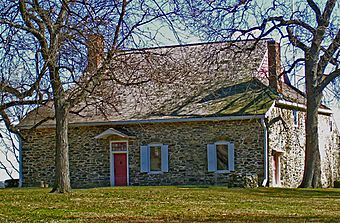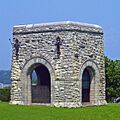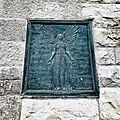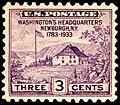Washington's Headquarters State Historic Site facts for kids
|
Washington's Headquarters
State Historic Site |
|

West (front) elevation, 2006
|
|
| Location | Newburgh, New York |
|---|---|
| Area | 7 acres (2.8 hectares) |
| Built | 1750-1770 |
| Architectural style | Dutch Colonial, Federal Revival |
| Website | https://parks.ny.gov/historic-sites/17/details.aspx |
| NRHP reference No. | 66000887 |
Quick facts for kids Significant dates |
|
| Added to NRHP | October 15, 1966 |
| Designated NHL | January 20, 1961 |
Washington's Headquarters State Historic Site, also known as Hasbrouck House, is a special place in Newburgh, New York. It sits high above the Hudson River. This historic house was where George Washington and his team stayed during the last year and a half of the American Revolutionary War. It was his longest stay at any headquarters during the war, lasting over 16 months.
New York State bought this house in 1850. It was the very first property in the United States bought and saved by a state government for its history. The Hasbrouck House is the oldest house still standing in Newburgh. It was added to the National Register of Historic Places in 1966.
Contents
- Building History: From Farmhouse to Headquarters
- General Washington's Home During the War (1782–1783)
- A King for America? The Newburgh Letter
- A Difficult Decision: The Asgill Affair
- Honoring Heroes: The Badge of Military Merit
- A Grand Review at Verplanck's Point
- Washington and Rochambeau's Last Meeting
- A Threat to Democracy: The Newburgh Conspiracy
- The War Ends: Cessation of Hostilities
- Washington's Advice for a New Nation
- After the War (1783–1850)
- America's First Historic Site (1850–Present)
- Visiting the Site
- Honors and Commemoration
- See also
Building History: From Farmhouse to Headquarters
The first small stone farmhouse on this spot might have been built around 1725. Later, in 1750, Jonathan Hasbrouck and his wife Catherine built the house we see today. They added more rooms in 1760 and again in 1770, making the house much bigger. The Hasbrouck family used their land for farming and later built a mill and a dock to trade goods.
The house is built in a style called Dutch Vernacular. This means it has features common in Dutch homes of that time. One special feature is the "Dutch Jambless" fireplaces. These fireplaces are built right into the wall without a mantelpiece. The Hasbroucks used one of these as their kitchen.
General Washington's Home During the War (1782–1783)
On April 1, 1782, General George Washington moved into the Hasbrouck family farmhouse. This made Newburgh the main headquarters for the Continental Army. He stayed here officially until August 19, 1783. Even though it was his official headquarters, Washington traveled a lot. He visited places like Philadelphia and West Point for army and government business.
Washington's time at the Hasbrouck House was his longest stay at any of his many headquarters during the war. Before he arrived, the army made some changes to the house. They built a temporary kitchen outside and improved other buildings like stables. Inside, Washington's bedroom got a new fireplace and a door leading to the outdoor kitchen.
Washington had a team of nine aides-de-camp who helped him with his daily tasks. These officers lived and worked at the headquarters with him. They were important for managing the army's needs.
Most of the Continental Army, about 7,500 soldiers, stayed nearby. They were at the New Windsor Cantonment, a few miles away. About 500 women and children also lived there with the soldiers.
A King for America? The Newburgh Letter
In March 1782, Washington received a surprising letter from an officer named Lewis Nicola. Nicola was worried that the Congress of the Confederation was too weak. He thought that all republican governments would struggle. He suggested that Washington should become the king of the United States. Nicola believed a king would be stronger and better for the country.
Washington strongly disagreed with this idea. He knew that many people feared a powerful leader like a king. He wanted America to be a republic, not a monarchy. Washington wrote back, saying that Nicola's suggestion caused him "painful feelings." He said that such ideas should not be in the army. Because of Washington's strong rejection, Kings Highway, the street where the headquarters is, was renamed Liberty Street.
A Difficult Decision: The Asgill Affair
During Washington's time in Newburgh, a serious problem arose. It involved American and British soldiers in New Jersey. In 1782, American soldiers executed a British loyalist. In return, British loyalists executed an American captain named Jack Huddy. American soldiers were very angry and demanded justice.
Washington faced a tough choice. He ordered that a British officer, chosen by chance, should be executed in return. This decision could have broken agreements made during the war. Captain Charles Asgill was chosen. However, leaders from France, including King Louis XVI, stepped in to help. After much discussion, Asgill's execution was stopped. This avoided a major international problem and protected Washington's reputation.
Honoring Heroes: The Badge of Military Merit
On August 7, 1782, Washington created the Badge of Military Merit. This award was for regular soldiers and non-commissioned officers. It honored them for long, loyal service and brave actions. It was given to only three sergeants: William Brown, Elijah Churchill, and Daniel Bissell. Washington personally gave them these badges on the lawn of the headquarters.
This badge is thought to be the first military award in the United States. It is also the second oldest in the world. For many years, people forgot about the badge. But in 1931, General Douglas MacArthur decided to bring it back. A specialist named Elizabeth Will redesigned the medal. It became known as the Purple Heart. The new design shows a picture of George Washington. It was first given out on Washington's 200th birthday.
A Grand Review at Verplanck's Point
On August 31, Washington and his army marched south to Verplanck's Point. There, Washington held a special parade for the French Commander-in-Chief, Comte de Rochambeau. Rochambeau and his army were on their way to Boston. The Continental Army wore their best uniforms and marched perfectly. Washington wrote that the troops should "pay him the honors due the commander in chief." After the parade, Washington returned to the Hasbrouck House.
-
Washington at Verplanck's Point, a painting by John Trumbull
Washington and Rochambeau's Last Meeting
After leaving Boston, Rochambeau passed through Newburgh on his way to France. This was the very last time Generals Washington and Rochambeau met. They were the two leaders who had won the Battle of Yorktown together.
A French general named François Jean de Beauvoir, Marquis de Chastellux, who often worked with both leaders, arrived first. He wrote in his diary about the headquarters house. He described it as "neither spacious nor convenient" and built in the "Dutch fashion." He noted the dining room had "seven doors and only one window."
Rochambeau arrived on December 7, 1782. It is not known what they talked about. But since Rochambeau soon left for France and never returned, this meeting was their final goodbye.
A Threat to Democracy: The Newburgh Conspiracy
In March 1783, many army officers were upset. They had not been paid by Congress for their service. Some politicians secretly encouraged them to act. Officers at the nearby New Windsor Cantonment started circulating a letter. It suggested that if peace was declared and they were still unpaid, they should refuse to disband the army. Some even thought about marching against Congress. This was a dangerous idea that could have led to a military takeover of the government.
Washington knew this was a huge threat to the new country's democracy. He decided to face the problem directly. He gave a powerful speech, known as the Newburgh Address. He persuaded his officers to stay loyal to Congress and to their republican principles. His leadership prevented a crisis and saved the young American democracy.
The War Ends: Cessation of Hostilities
A month later, on April 19, Washington announced the Proclamation for the Cessation of Hostilities. This meant a preliminary peace treaty had been reached with Great Britain. He ordered the army to officially stand down. This marked the end of the fighting in the American Revolution. It was exactly eight years since the war began at the Battles of Lexington and Concord. Washington urged everyone to celebrate this peace and give thanks.
Washington's Advice for a New Nation
In the summer of 1783, Washington wrote an important open letter. It was called the "Circular Letter to the States." In it, he gave advice on how the new nation could succeed. He said America had many advantages, like its large size and natural resources. He also stressed that the country was founded on ideas of liberty and equality.
Washington warned that the world would be watching America's experiment with self-government. If they succeeded, it would prove that democracy worked. If they failed, it would be a setback for republicanism everywhere.
He then shared four key ideas for success:
- There needed to be a strong national government to keep the states united.
- All debts from the Revolutionary War should be paid quickly.
- The state militias, which defended the country, should be well-trained and equipped.
- Citizens should think of themselves as Americans first, not just as people from their home state. They should be willing to help the whole country.
Washington ended by saying he wanted to retire peacefully from public life.
After the War (1783–1850)
After Washington left, the Hasbrouck House went back to Mrs. Hasbrouck. Later, it was owned by her grandson, Jonathan III. In 1833, two of his daughters opened a school for local women in the house.
Jonathan III faced financial problems in 1837. The house was put up for sale. People started to realize how important the house was historically. Many wanted to save it. Even writer Washington Irving hoped to preserve it. In 1848, the state of New York took ownership of the house because of Jonathan's debts.
Leaders like Andrew J. Caldwell and Governor Hamilton Fish strongly supported saving the house. On April 10, 1850, a law was passed to preserve Washington's Headquarters.
America's First Historic Site (1850–Present)
When New York State bought the house in 1850, it became the first historic site in the country to be run by the public. It opened to visitors on July 4, 1850. For many years, historical items were displayed inside the house. But in 1910, a new brick building was built next door. This building became a museum and visitor center.
Today, the Hasbrouck House looks much like it did when General Washington lived there. Most of the items inside are copies, but some are real artifacts connected to Washington. The site covers about 7 acres. It includes the Hasbrouck House, the 1910 museum, a monument called the "Tower of Victory", and a maintenance building.
The site was named a National Historic Landmark in 1961.
The Tower of Victory
In the northeast part of the site, you'll find a large stone monument called the Tower of Victory. It opened in 1887. The tower celebrates 100 years since the Continental Army successfully disbanded.
The Tower was a project by both the federal and state governments. Robert Todd Lincoln, son of Abraham Lincoln, helped lead the planning. Architect John H. Duncan designed the monument. He also designed Grant's Tomb in New York City. The Tower is meant to look strong and simple, like the revolutionary times. Visitors can go to the top for views on guided tours.
There are four bronze statues on the outside of the Tower. They represent different types of soldiers in the Continental Army: a Rifleman, a Light Dragoon, an Artilleryman, and an Infantry Line Officer. Inside, there was a life-sized statue of George Washington. It is currently being repaired.
In 1950, a hurricane damaged the Tower's original roof. It was closed for many years. A new roof was finally installed in 2019.
Other Monuments and Memorials
The site also has other monuments that tell unique stories from history.
One is the grave of Uzal Knapp. He was a veteran of the Continental Army. He claimed to be the last living member of Washington's special guard. He was buried here with military honors in 1856. A monument was placed over his grave four years later.
Another monument is a statue called The Minuteman. It was put on the grounds in 1924. It looks very similar to another statue at the site of the Battles of Lexington and Concord. The artist, Henry Hudson Kitson, wanted these statues to mark the beginning and end of the Revolutionary War. The war started at Lexington on April 19, 1775, and effectively ended at Newburgh on April 19, 1783.
There is also a small plaque outside the house for First Lieutenant Judson P. Galloway. He was a local Newburgh man who died bravely in World War I in 1918. He was honored for his "extraordinary heroism."
Visiting the Site
Washington's Headquarters State Historic Site is open to visitors all year. During the summer (mid-April to mid-October), it's open Wednesday through Saturday from 11 am to 5 pm, and Sunday from 1 pm to 5 pm. In the winter (mid-October to mid-April), it's open Fridays and Saturdays from 11 am to 3 pm. You can also visit by appointment on other weekdays.
You need to buy tickets at the museum to see the exhibits, the Headquarters house, and the Tower of Victory. The museum galleries are self-guided. However, to see the Headquarters and the Tower, you must take a tour with a guide.
Honors and Commemoration
On April 19, 1933, the U.S. Post Office released a special stamp. It showed Washington's Headquarters at Hasbrouck House overlooking the Hudson River. This was to celebrate 150 years since Washington announced the end of fighting. The headquarters is also featured on the flag of the city of Newburgh.
See also
- List of Washington's Headquarters during the Revolutionary War
- List of National Historic Landmarks in New York
- National Register of Historic Places listings in Orange County, New York
- Knox's Headquarters State Historic Site, another historic site nearby
- New Windsor Cantonment State Historic Site, the final camp of the Continental Army















